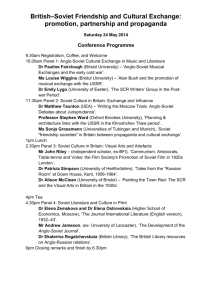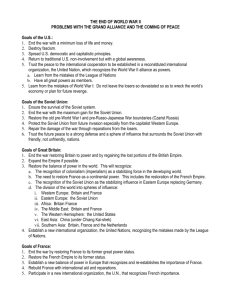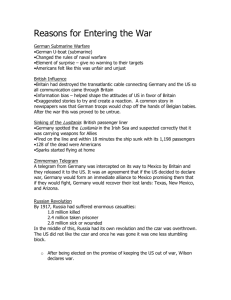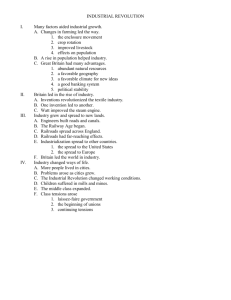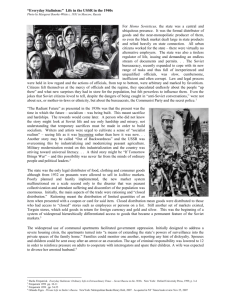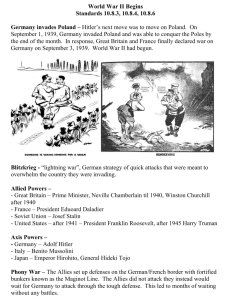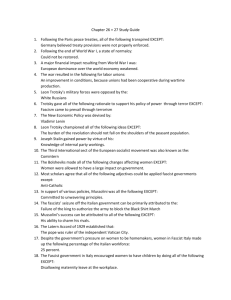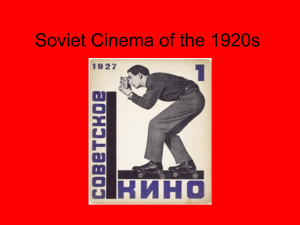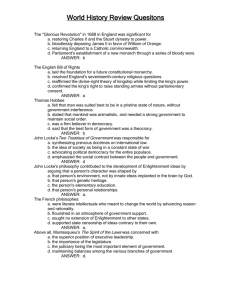1 APEH—2009 Multiple Choice Test Please do not write
advertisement
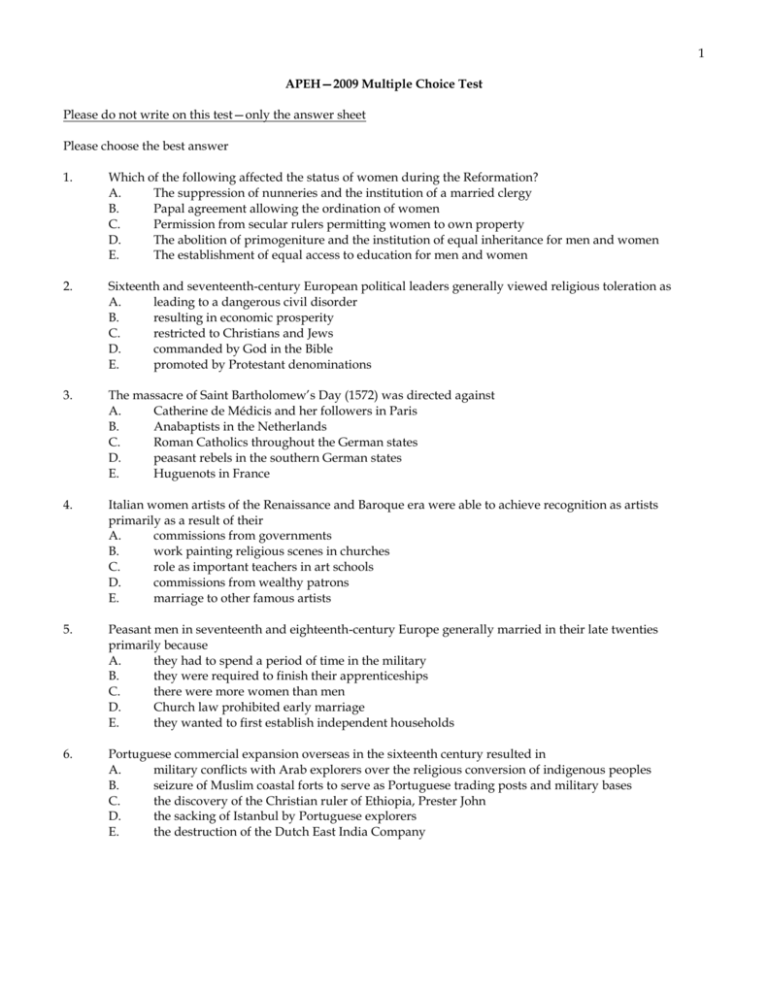
1 APEH—2009 Multiple Choice Test Please do not write on this test—only the answer sheet Please choose the best answer 1. Which of the following affected the status of women during the Reformation? A. The suppression of nunneries and the institution of a married clergy B. Papal agreement allowing the ordination of women C. Permission from secular rulers permitting women to own property D. The abolition of primogeniture and the institution of equal inheritance for men and women E. The establishment of equal access to education for men and women 2. Sixteenth and seventeenth-century European political leaders generally viewed religious toleration as A. leading to a dangerous civil disorder B. resulting in economic prosperity C. restricted to Christians and Jews D. commanded by God in the Bible E. promoted by Protestant denominations 3. The massacre of Saint Bartholomew’s Day (1572) was directed against A. Catherine de Médicis and her followers in Paris B. Anabaptists in the Netherlands C. Roman Catholics throughout the German states D. peasant rebels in the southern German states E. Huguenots in France 4. Italian women artists of the Renaissance and Baroque era were able to achieve recognition as artists primarily as a result of their A. commissions from governments B. work painting religious scenes in churches C. role as important teachers in art schools D. commissions from wealthy patrons E. marriage to other famous artists 5. Peasant men in seventeenth and eighteenth-century Europe generally married in their late twenties primarily because A. they had to spend a period of time in the military B. they were required to finish their apprenticeships C. there were more women than men D. Church law prohibited early marriage E. they wanted to first establish independent households 6. Portuguese commercial expansion overseas in the sixteenth century resulted in A. military conflicts with Arab explorers over the religious conversion of indigenous peoples B. seizure of Muslim coastal forts to serve as Portuguese trading posts and military bases C. the discovery of the Christian ruler of Ethiopia, Prester John D. the sacking of Istanbul by Portuguese explorers E. the destruction of the Dutch East India Company 2 7. “If a prince wants to maintain his rule, he must learn how not to be virtuous, and to make use of this or not according to his need.” The passage above best reflects the argument of A. Thomas More B. Machiavelli C. Louis XIV D. Frederick the Great E. Napoleon I 8. “Our sins have their source in Adam, and because Adam ate the apple, we have inherited sin from him. But Christ has shattered death in order that we might be saved by His works and not by our works. Christ says: I am your justification.” --Martin Luther Which of the following best describes Luther’s meaning in the excerpt above? A. Only faith in Christ will bring salvation, not good works. B. “Justification” is different from “salvation.” C. Faith means nothing without good works to demonstrate belief. D. Good works are necessary for justification, but only faith in Christ will bring salvation. E. Neither faith nor good works will bring salvation. 9. The map to the side, showing religious divisions in Europe around 1600, illustrates which of the following differences between Lutheranism and Calvinism? A. Lutheran areas were more densely populated and urbanized than were Calvinist areas. B. Lutheran areas were geographically closer to papal influence than were Calvinist areas. C. Calvinist areas were more likely to be influenced by minor sects than were Lutheran areas. D. Calvinists were more likely to share a common language than were Lutherans. E. Calvinists were more likely to be a minority within the state than were Lutherans. 10. Lorenzo Valla’s demonstration that the Donation of Constantine was fraudulent weakened the papacy’s claim A. that Lutheranism was a heresy B. of supremacy over the Orthodox Church C. that good works were necessary for salvation D. to extensive territories in Italy E. to supremacy over church councils 3 11. Which of the following best describes the results of the Peace of Augsburg (1555)? A. It empowered German rules to impose Lutheran, Calvinist, or Zwinglian Protestantism. B. It was rejected by the Emperor Charles V. C. It released all German-speaking states from papal authority. D. It established toleration for Anabaptists in the Holy Roman Empire. E. It provided a legal basis for the existence of Lutheranism. 12. The conversion to Catholicism of King Henry IV of France is an example of the policies of the A. Jansenists B. politiques C. philosophes D. physiocrats E. Jacobins 13. “O highest and most marvelous felicity of man! To him it is granted to have whatever he chooses, to be whatever he wills.” The excerpt above is representative of the ideas of A. Jean-Jacques Rousseau, Social Contract B. Thomas Hobbes, Leviathan C. Pico della Mirandola, On the Dignity of Man D. Martin Luther, Address to the Christian Nobility of the German Nation E. Karl Marx and Friedrich Engels, Communist Manifesto 14. Which of the following best describes the French Edict of Nantes (1598)? A. It provided limited political and religious liberties for French Huguenots. B. It signaled the end of French territorial expansion for a century. C. It led to the establishment of French colonies in North America. D. It granted legal equality to all classes in France. E. It led to fifty years of violent peasant rebellions. 15. “That the pretended powers of suspending of laws or the execution of laws by regal authority without consent of Parliament is illegal. That levying money for or to use of the Crown by pretence of prerogative without grant of Parliament for longer time or in other manner than the same is illegal.” The provisions above from the English Bill of Rights were enacted in response to A. Henry VIII’s divorce of Catherine of Aragon despite Parliament’s disapproval B. Elizabeth I’s refusal to sign the death warrant against Mary, Queen of Scots C. James II’s attempt to dominate Parliament D. opposition aroused by the joint rule of William and Mary E. the ineffectual rule of George I 16. One of the main aims of the reforms in Russia under Peter the Great (1689-1725) was to make high social status more dependent on A. aristocratic lineage B. service to the state C. wealth D. ethnic origin E. membership in the Orthodox Church 4 17. The most influential religious order associated with the Catholic Reformation (Counter-Reformation) was the A. Brothers and Sisters of the Common Life B. Dominican C. Franciscan D. Jesuit E. Oratory of Divine Love 18. The emblem to the right was used as a symbol for which of the following? A. Napoleon I B. Voltaire C. Louis XIV D. Colbert E. Cardinal Mazarin 19. All of the following were common subjects of Italian Renaissance works of art EXCEPT A. equestrian statues B. nude figures C. portraits D. figures from mythology E. peasant life 20. Which of the following was the major language spoken in most courts and diplomatic circles of Europe by the late 17th century? A. German B. French C. English D. Spanish E. Italian 21. In seventeenth century Poland, the most significant political influence was exercised by the A. nobility B. town councils C. Polish monarch D. Russian monarch E. Habsburg Empire 22. The French Fronde is best described as the A. first government formed after the French Revolution B. civil war fought between Roman Catholics and Protestants C. revolt over increasing centralization of royal power D. wars between France and the Holy Roman Empire E. style of architecture developed under Louis XIV 23. The Dutch church represented in the painting to the right can be identified as Protestant because A. its high vaulted ceiling B. the small number of people in attendance C. the absence of pews or chairs D. the plainness of the interior E. its windows at different levels 5 24. Which of the following cities dominated European trade and finance in the early seventeenth century? A. Venice B. Paris C. London D. Amsterdam E. Madrid 25. The cartoon to the right from seventeenth-century England is an attempt to ridicule A. support of William and Mary by the Dutch B. fighting between royalist and parliamentary armies during the English Civil War C. the movement of Puritans to the New World D. the widespread practice of wagering on dog fights E. the refusal of Quakers to bear arms and fight 26. The most important political and military result of the Thirty Years’ War and the Peace of Westphalia was the A. decline of Denmark as a Baltic power B. decline of the Ottoman Empire as a great power C. rise of English naval power D. rise of Russia as a great power E. rise of France as a great power 27. Which of the following represents the final defeat of efforts by the Ottoman Empire to acquire large areas of central Europe? A. The battle of Poltava (1709) B. The battle of Lepanto (1571) C. The battle of Nördlingen (1634) D. The siege of Vienna (1683) E. The fall of Constantinople 28. Elizabeth I's major goal in foreign policy was to? A. avoid open warfare whenever possible and keep England strong and at peace. B. start rebellions against the Scots. C. marry one of the available foreign kings or heirs to their thrones. D. create a democratic republic in England. E. go to war with France and recapture lands lost by England during the Hundred Years' War. 29. Religious change in the seventeenth-century Netherlands led to A. great vitality in intellectual and artistic life B. an emphasis on decorative rather than fine arts C. a rebirth of fresco painting in the churches D. the exclusion of women artists from portrait painting E. the establishment of official censorship to purge Catholic influences from the arts 6 30. The cartoon to the right illustrates which of the following? A. Renaissance rejection of medieval Christianity B. Late-eighteenth century calls for abolition of the Atlantic slave trade C. Social inequalities under the Old Regime in France D. Aristocratic hostility to Peter the Great’s efforts to westernize Russia E. Napoleon’s suppression of the Spanish nationalist movement 31. “Since my accession to the throne, I have ever been anxious to conquer prejudices and to gain the confidence of my people. I granted toleration, and removed the yoke which had oppressed Protestants for centuries. Tolerance is a convincing proof of the improvement of the human mind.” The author of the quotation above was most likely a A. German ruler who had declared for Lutheranism B. monarch devoted to the concept of absolutism C. ruler influenced by Enlightenment precepts D. sixteenth-century Russian tsar E. Catholic ruler in the time of the Catholic Reformation 32. Which of the following diseases did NOT produce a major epidemic after the eighteenth century? A. Measles B. Typhus C. Influenza D. Cholera E. Bubonic plague 33. “Up! up! my Friend and quit your books; Let nature be your teacher. One impulse from a vernal wood May teach you more of man, Of moral evil and of good Than all the sages can. Enough of Science and Art; Come forth, and bring with you a heart.” The poem above reflects which of the following? A. Futurism B. Existentialism C. Romanticism D. Deism E. Pragmatism 34. Which of the following is true regarding the salons of the eighteenth century? A. They were exclusively a French phenomenon. B. They excluded women. C. They discussed social questions as well as literary works. D. They were held exclusively at royal courts. E. They were endorsed by traditional religious leaders. 7 35. A major result of the War of the Spanish Succession (1701-1713) and the Treaty of Utrecht (1713-1714) was to A. unite the Spanish and French thrones under a Bourbon ruler B. finalize the decline of the British navy after a short-lived domination C. cause a long-term decline in international commerce and trade D. introduce significant new developments in warfare and weapons E. prevent France from upsetting the balance of power 36. “I asked him to tell me in what true religion consisted. ‘Have I not told you?’ [he answered] ‘Love God and your neighbor as yourself.’” --Voltaire, Philosophical Dictionary In the excerpt above, Voltaire was supporting A. religious toleration B. papal authority C. unification of all Christian churches D. Protestantism E. the monastic life 37. According to Adam Smith, the “invisible hand” would A. provide checks and balances among the branches of government B. convince devout men and women of the value of religious toleration C. reconcile selfish individual interests with general economic benefits D. guide absolute monarchs to embrace liberal reforms E. cause population to exceed available food supplies 38. A controversial aspect of the Agricultural Revolution in eighteenth-century England was the transformation of common land into private land through the process known as A. enclosure B. puddling C. asiento D. crop rotation E. syndication 39. The contemporary drawing to the right of the storming of the Bastille was intended to portray A. aristocratic support for the old regime B. popular participation in the revolutionary process C. the determination of the military to resist change at any cost D. peasants protesting high rents for land E. the imprisonment of Louis XVI and Marie Antoinette after the September Massacres 40. A distinguishing feature of the Old Regime in eighteenth-century France was the A. dominant influence of the Roman Catholic Church on the cultural life of the elites B. steady decline in the peasant population C. growth of modern machine industry in manufacturing centers such as Lyon D. inability of the monarchy to carry out reforms necessary for its survival E. mass emigration to the colonies in the New World 8 41. Napoleon Bonaparte’s repressive occupation sparked a violent popular revolt in A. Spain B. Italy C. Austria D. Poland E. Great Britain 42. The basic goal of Napoleon’s Continental System was to A. isolate Russia diplomatically B. weaken England economically C. unite France and Spain D. unify Germany E. conquer Italy 43. The meeting of the Estates-General in 1789 marked a significant step toward revolution in France because it A. exposed the plans of Louis XVI to abdicate in favor of his son B. provided a legitimate forum for critics of the Old Regime C. included a proposal to confiscate noble estates to raise government revenue D. revealed the extent of papal influence on the French royal family E. gave the clergy and the nobility an opportunity to overthrow the monarchy 44. The cahiers written on the eve of the French Revolution served which of the following purposes? A. To present grievances and proposals for reform B. To form the basis of a new constitution and code of laws C. To represent the guilds’ interests to the aristocracy and bourgeoisie D. To restore the aristocracy to a full partnership with the monarchy E. To make the clergy responsible to the national bureaucracy 45. The American Revolution played a major role in European history because it A. inspired the United Irish Rebellion B. led Spain to repudiate its alliances with France and Great Britain C. created a new balance of power in favor of Great Britain D. precipitated the French fiscal crisis that led to the calling of the Estates-General E. inspired England’s Glorious Revolution 46. Which of the following was most responsible for the steady population growth in eighteenth-century Europe? A. A rising birth rate among all classes B. The virtual elimination of the bubonic plague through successful inoculation C. Greater freedom of choice in selecting marriage partners D. A steady decline in bread prices, especially after 1750 E. An overall decline in the death rate 47. The French Le Chapelier Law (1791) and the English Combination Acts (1799-1800) did which of the following? A. Raised customs taxes on imports B. Made workers’ organizations illegal C. Restricted child labor D. Provided state health care to railway employees E. Mandated a minimum wage 9 48. Which of the following escaped the revolutionary outburst of 1848? A. France B. Prussia C. Sweden D. Rome E. Austria 49. The British Great Reform Act of 1832 did which of the following? A. Gave women the right to vote. B. Granted universal male suffrage. C. Limited the power of the monarchy. D. Abolished the right of the House of Lords to veto legislation. E. Increased the voting power of the middle class. 50. Urban life in the major European cities during the Industrial Revolution was characterized by A. rapid social mobility among recent migrants from the countryside B. overcrowded living conditions and unsafe working conditions for the working poor C. the adoption of laissez-faire attitudes by industrial workers D. government control of major industrial companies E. an increase in the nobility’s power over the urban population 51. “The whole history of society up to now has been the history of class struggles. Our period, however, the bourgeois period, is distinguished by the fact that it has simplified class antagonisms. All society is splitting more and more into two great hostile camps, into two large classes opposing each other directly: bourgeoisie and proletariat.” Which of the following wrote the passage above? A. Prince von Metternich and Viscount Castlereagh B. Karl Marx and Friedrich Engels C. John Stuart Mill and Harriet Taylor D. Beatrice and Sydney Webb E. Benjamin Disraeli and William Gladstone 52. Which of the following is accurate about late-nineteenth century Socialist parties in western and central Europe? A. They generally supported imperialist expansion. B. They included members who emphasized electoral success and participation in government. C. They were effectively controlled by the First International. D. They publicly repudiated Marxism. E. They repudiated labor unions as supportive of a labor aristocracy and not of the mass of working people. 53. All of the following were part of Alexander II’s (r. 1855-1881) modernization of Russia EXCEPT the A. introduction of railroads and heavy industry B. abolition of serfdom C. creation of local assemblies (zemstvos) D. creation of a constitution E. reform of the legal code 10 54. One major consequence of the First World War was A. a long period of peace and stability in Europe B. the reestablishment of the Ottoman Empire C. the Russian Revolution D. greater prosperity for Great Britain and France E. greater Italian influence in European diplomacy 55. Of the following, nineteenth-century European women were relatively more numerous and made the most influential contributions as A. popular novelists and writers B. developers of the new biological sciences C. classical musicians D. members of parliaments E. architects and engineers 56. The term “Five Year Plans” would most likely be discussed in conjunction with which of the following? A. A book on urban planning in post-Second World War with England B. A work on German democratic socialism in the twentieth century C. A book on the economic development of the Soviet Union after the Bolshevik Revolution D. A monograph on French military security from 1920 to 1939 E. An examination of the influence of Keynesian economics in the 1930s 57. European liberals in the first half of the nineteenth century typically supported A. women’s suffrage B. accident and unemployment insurance C. the right of workers to unionize and strike D. a written constitution and wider suffrage E. the establishment of overseas colonies to improve conditions at home 58. One of the first economic unions in modern European history, founded in 1834 by a group of German states, was known as the A. Kulturkampf B. League of Augsburg C. Zollverein D. Confederation of the Rhine E. Concert of Europe 59. Which of the following best characterizes artistic movements in late-nineteenth-century Europe? A. An increased emphasis on personal expression B. A return to the restraint and symmetry of classical forms C. A rejection of nature as a subject D. Renewed dependence on royal and aristocratic patrons E. Concentration on religious themes 60. Which of the following was true of contraception in nineteenth-century Europe? A. It appeared first among working-class families. B. It initially has the support of the Roman Catholic Church. C. It reduced the size of rural families much more than that of urban families. D. It was practiced by middle-class parents seeking a higher standard of living for their families. E. It became popular as a result of the development of the birth control pill. 11 61. In the period after the First World War, the British economist John Maynard Keynes argued that A. price inflation was the primary threat to economic growth B. military spending should remain high even in peacetime C. governments should respond to economic downturns by increasing spending D. the best ideas of Adam Smith and Karl Marx could be reconciled E. government interference with the market created economic inefficiencies 62. Before the First World War, European feminists such as the Pankhursts had all of the following goals EXCEPT A. eliminating poll taxes B. opening up more professions to women C. liberalizing marriage and divorce laws D. broadening the franchise to include women E. establishing colleges for women 63. The political cartoon below from the 1930s illustrates (the caption reads “Why should we take a stand about someone pushing someone else when it’s all so far away…”) A. the perceived problem of European over-population B. British indifference to aggression by the Axis powers C. France’s dependence on goods from the British Empire D. Austria’s role as a buffer between the Soviet Union and the new states of central Europe E. Britain’s system of military alliances 64. The nineteenth-century term "White Man's Burden" reflects the idea that A. Asians and Africans were equal to Europeans. B. Europeans had a responsibility to improve the lives of their colonial peoples. C. imperialism was opposed by most Europeans. D. Asians and Africans would be grateful for European help. E. democracy was the best form of government for Asia and Africa. 65. A major economic problem in late-nineteenth-century Europe that contributed to European imperialist expansion was A. high wages that eroded companies’ profits B. increased transportation costs C. overproduction of manufactured goods D. lack of an educated workforce E. the need to alleviate labor shortages 12 66. The Treaty of Berlin in 1878 reflected general European agreement on which of the following? A. Reduction in tariffs and trade barriers B. The status of Poland C. The building of a railroad to Baghdad D. Boundaries and spheres of influence in the Balkans E. Reductions and limits on armaments 67. In the years immediately after the First World War, which of the following was the most important change affecting the status of German women? A. Married women were encouraged to have only one child. B. Women were invited to join the military. C. Women received the vote. D. Women’s clothing became less constricting. E. Many women gained equal pay with men. 68. All of the following developments during the 1930s contributed to improved relations between the Soviet Union on the one hand and Great Britain and France on the other EXCEPT A. Stalin’s purge of Bolshevik leaders B. capitalist desires for new markets C. Soviet desires for technology and markets D. the fear of fascism in German and Italy E. the rise of Popular Front governments 69. Which of the following best describes a primary goal of the Christian Democratic parties in Western Europe after the Second World War? A. Elimination of the welfare state B. Separation of church and state C. Continuation of a strong anticommunist foreign policy D. Maintenance of ethnic and national boundaries E. Establishment of a worker controlled state 70. Of the following, which contributed most to Germany’s defeat in the First World War? A. The spread of influenza among the German army and civilian population B. The effects of the Allied naval blockade C. The Allied use of submarine warfare D. The collapse of the Russian army in 1917 E. The Allied threat to use poison gas 71. Which of the following was originally part of German Nazism but not of Italian fascism? A. anti-communism B. anti-Semitism C. political violence D. the replacement of a democratically elected government E. a single charismatic figure 72. The Conservative government of Margaret Thatcher (1979-1990) is associated with all of the following EXCEPT A. military intervention in the Falkland Islands B. cuts in government spending for education and health programs C. government ownership of heavy industry D. reduction in income taxes to spur investment E. criticism of the political power of labor unions 13 73. During the Spanish Civil War, the Nationalist forces led by General Franco received military assistance from which of the following pairs of states? A. France and Italy B. France and the Soviet Union C. Germany and Great Britain D. Germany and Italy E. the Soviet Union and the United States 74. The term “Prague Spring” refers to the A. impact of the French Revolution on Czech intellectuals B. uprising in Prague in 1848 C. founding of the Republic of Czechoslovakia in 1918 D. liberation of Czechoslovakia from the Nazis in 1945 E. reforms by the Czechoslovak government in 1968 75. Which of the following occurred as a result of the Organization of the Petroleum Exporting Countries (OPEC) led oil embargo of the 1970s? A. A rapid rise in inflation and unemployment in the developed world B. The overthrow of the Saudi Arabian monarchy C. A peace treaty between Israel and Jordan giving Jordan control of Jerusalem D. An increase in the volume of world trade E. The expansion of OPEC to include the Soviet Union 76. Which of the following helped trigger the collapse of the Soviet Union in 1991? A. Subversion by the United States and its European allies B. The failure of a hardline coup and Boris Yeltsin’s leadership in Moscow C. The resistance of Soviet leaders such as Mikhail Gorbachev to necessary reforms of the Soviet system D. The failure of the Soviet Union to modernize its military forces and its intelligence apparatus E. The political alliance of Mikhail Gorbachev and Andrei Sakharov 77. Which of the following did European nations commit to when they signed the Treaty of European Union (Maastricht Treaty) in 1992? A. The adoption of a single official language for Europe B. A new agricultural policy to increase productivity C. A united effort to promote basic human rights outside of Europe D. The introduction of a common currency E. The establishment of a unified military force for all member nations 78. Political violence and armed conflict in the first and last decades of the twentieth century resulted from disputes over the status of what territory? A. Alsace-Lorraine B. Poland C. Belgium D. Romania E. Bosnia 14 79. Despite the wartime leadership of Conservative prime minister Winston Churchill, the Conservative Party was defeated by the Labour Party in the British elections of 1945 largely because of A. widespread frustration over the failure of Britain to develop the atomic bomb B. fear that Churchill would prove weak in postwar dealings with the Soviet Union C. concern that Churchill and the Conservative Party would not do enough to alleviate economic hardship in postwar Britain D. worries that joining the United Nations would make it impossible for Britain to have an independent foreign policy E. popular desire to maintain British imperial rule in India for as long as possible 80. Which of the following was most directly responsible for the founding of the Fifth Republic in 1958? A. Economic recession B. The Suez Crisis C. The French defeat at Dien Bien Phu D. Political conflict over the war in Algeria E. The resignation of Prime Minister Charles de Gaulle

